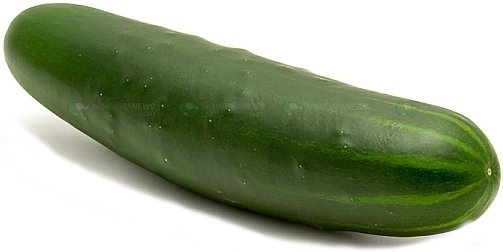

Cucumbers
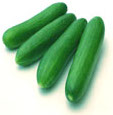
The species that are cultivated for food are Cucumis sativus (cucumber), and Cucumis anguria (West Indian gherkin). True Cucumis sativus originated in Sino-Himalaya, where it is now very rare. Cucumis anguria is a cultigen probably derived from the African Cucumis longipes. Cucumbers are frost-susceptible annuals, of vigorous trailing growth. They need a long period of warm, preferably dry, weather for satisfactory performance; humid conditions favour infection by disease. They can be grown in the open throughout their life in tropical and subtropical climates, needing a warm, frost-free period of 100 to 140 days from sowing to harvest. In temperate climates plants are grown for all or part of their life under protection. Fruits of cucumbers are eaten when immature. Cucumbers need a fertile, well-drained soil, but resent low pH. The root systems are relatively shallow but wide-spreading. Early preparation of the soil should include generous incorporation of organic materials (25-30 tonnes per hectare). On a field scale in warm climates, the plants are grown in rows or on hills, the spacing depending on the amount of growth expected from the crop; allow 60-90cm between the hills and 90-120cm between the rows. For direct sowing, a warm soil is required, a temperature of 35ºC being optimum. Plants for field culture in climates where the frost-free period is shorter are often started in a greenhouse and transplanted when the first leaves appear. Direct-sown plants are thinned at that stage to 2-3 per hill, or to 15-30cm apart in the row. Cultivation of weed control is carried out until the trailing shoots (vines) have covered the space between the rows. Such vigorous plants require a lot of water, and regular irrigation has given increased yields. Cucumbers need regular picking to ensure that they are not over-mature. In colder climates with a relatively short frost-free season, plants are grown for all or part of the cultural period under protection. Soil preparation, whether for indoor or outdoor cultivation, requires generous incorporation of organic materials (e.g. well-rotted manure), but drainage must also be good as the plants react badly to waterlogging. 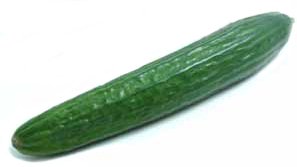
In temperate countries, cucumbers are grown in greenhouses or frames throughout their life. The greenhouse temperature is maintained at about 21ºC and the air should be kept humid. Seeds are sown singly in pots at a temperature of 21ºC, reduced to 15ºC after germination. Plants are then transplanted in greenhouse beds at 60cm apart, for training up the side walls. The main shoot is trained vertically up the wires, and stopped at about 135cm to allow lateral shoots to develop; later growth of the main shoot is trained up to the roof. Fruits are borne on the laterals, allowing only two flowers to develop on one lateral. In frames one plant is planted at the back, training three shoots towards the front. Plants are trimmed and stopped as they grow to space the shoots and allow room for fruit development. Ridge cucumbers and gherkins are hardier and can be grown outside in temperate countries although they need protection in the seedling stage. They may be sown direct or sown under glass in spring at a temperature of at least 23ºC. They are transplanted outside spaced at about 60cm or 45cm depending on whether thay are to be grown on ridged beds over the soil or trained up trellis or netting. The tips are pinched out when seven leaves are formed. Flat-grown plants are mulched with straw to keep the fruits clean. West Indian gherkin is grown in Central America, the West Indies, Brasil and the southern US. The fruits are up to 6cm long and are eaten when still immature, peeled and raw or are pickled. Cultural requirements are similar to those for cucumber in the tropics. Cucumis metuliferus, the Kiwano or horned cucumber, of tropical African origin, has been developed as a commercial fruit in New Zealand. The fruit, 10cm long and orange when ripe, is oval and covered with short conical protruberances. Although reputed to combine the flavour of banana, lemon and passionfruit, it is rather insipid. Recommended glasshouse cucumbers include ‘Telegraph’ and ‘Telegraph Improved’, ‘Pepinex’ (spineless, all-female flowers), ‘Petita F1’ (short-fruited, high-yielding), ‘Radja’, short-fruited, and ‘Santo F1’. Reliable outdoor cucumbers are ‘Burpee Hybrid’, ‘Burpless Tasty Green’, ‘Bush Crop’ (dwarf, compact), ‘Bush Champion’, ‘King of the Ridge’, ‘Kyoto’ (long and thick), ‘Long Green’, ‘Marketmore 76’, ‘Straight Eight’ and ‘Sweets Success’. ‘Crystal Apple’ has round fruits, golden yellow with dark flecks. Pickling varieties or gherkins include ‘Arena’, ‘Gherkins Pariser’ (the French cornichon), ‘Picklebush’, ‘Salty’ and ‘Pioneer’. 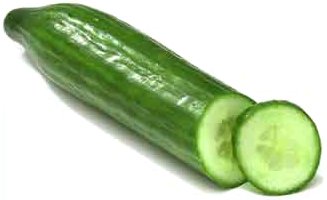 Cucumis
Cucumis
(Latin cucumis, cucumber.) Cucurbitaceae. About 30 species of herbs, scandent or climbing, annual or perennial, monoceious or andromonoecious. Stem hispid or scabrid. Tendrils simple. Leaves simple, occasionally divided, palmate, angled or 3-7-lobed, usually scabrid or hispid. Male flowers solitary or borne in short, lateral clusters, yellow, 1-2cm diameter; calyx tubular, lobed; lobes filiform; petals 5, joined near base; stamens 3, free, inserted on perianth tube, anthers flexuous; nectary cup central; disc subglobose; female flowers solitary, occasionally clustered, similar to male flowers except stamiondes 3; ovary ovoid or globose, pubescent, nectary ring at base of style; disc annular. Fruit indehiscent, fleshy, smooth or spiky; seeds lenticular, acute. Tropical Africa, Asia, introduced to New World Tropics. Z10. Cucumis africansMonoecious annual trailer. Stems grooved, hirsute to pilose, becoming scabrid, to 1m. Leaves 2-10cm, palmate, ovate, cordate, setose, lobes 3-5 rarely 7, broadly elliptic to lanceolate, obtuse to acute, dentate to subentire, median lobe largest, often lobulate; petioles hispid, to 7cm. Male flowers solitary or in racemes; receptacle hirsute; sepals subulate to filiform, to 4mm; corolla yellow, 10-15mm; female flowers solitary, similar to male except ovary fusiform to oblong. Fruit variable, ellipsoid to subcylindric, spiny, pale green with purple bands. S Zimbabwe to S Africa. Cucumis anguriaWEST INDIAN GHERKIN; BUR GHERKIN; GOARBERRY; GOOSEBERRY GOURD. To 2.5m. Stems slender, angled, rough, pubescent. Leaves to 8cm, broadly ovate, cordate, venation pubescent, lobes 3-5, rounded, often lobulate, basal lobes asymmetric. Male flowers solitary or cymose; calyx tube about 3cm; petals yellow, 5-6 x 3-4cm; female flowers solitary, perianth similar to male; ovary ellipsoid, to 5 x 8mm, bristly; pedicel 13-95mm. Fruit ovoid or oblong, to 5 x 4cm, prickly, grey-green with green stripes, becoming yellow. Tanzania to the Transvaal. variety longipes. Fruit concolorous, with dense subulate spines. W & S Africa. Cucumis dipsaceusHEDGEHOG GOURD; TEASEL GOURD. Annual. Roots fibrous. Stem slender, grey-green, hispid. Leaves 2-10 x 3-10cm, broad-ovate to reniform-ovate, scabrid-pubescent especially on veins beneath, occasionally shallowly 3-lobed; petiole pubescent, 3-1cm. Male flowers 1-4; calyx tube to 5mm, pale green; petals yellow with green nerves, to 10 x 5mm; female flowers solitary, petals larger than male; ovary ellipsoid, bristly. Fruit firm, soft-spiny, ellipsoid, 2-5cm; stalk stout, about 1cm; seeds elliptic, to 5mm. Arabia, NE Africa.  Cucumis melo
Cucumis melo
MELON. Annual, occasionally perennial, trailing or prostrate. Stems angular and hirsute to terete and glabrous. Leaves 5-15 x 5-15cm, membraneous, subreniform, obtuse, 5-angled or shallowly 3-5-lobed, soft villous throughout, the veins especially, lobes broad, rounded; petiole hispid-pubescent, 3-10cm. Male flowers in fascicles; females solitary; calyx tube villous, 5-8mm, lobes subulate; corolla 1-2cm; ovary ellipsoid to cylindric, pubescent. Fruit 3-10 x 2-7cm, highly variable in cultivation; seeds white, emarginate, oblong, compressed. Cutlivated throughout warmer regions. subspecies melo. SWEET MELON; MUSK MELON. Annual. Leaves softly pubescent. Flowers 2-3cm. Fruit subspherical to ellipsoid. Many cultivars varying in fruit characteristics cultivated throughout the tropics and subtropics. variety flexuosus. Fruit elongated, furrowed, to 90cm. subspecies agrestis. Ovary densely puberulous, with adpressed forward-pointing hairs. Cultivated in India and Pakistan. variety momordica. Fruit ovoid to cylindric, glabrous, yellow, 30-60 x 7-15cm. Cucumis metuliferusAFRICAN HORNED CUCUMBER. Annual, climbing or trailing. Stem hispid-pubescent. Leaves 4-10cm, broadly ovate, cordate, usually 3-lobed, serrate, long-pubescent especially on nerves beneath, lobes ovate-triangular; petioles long-pubescent. Male flowers in clusters, 1-4-flowered, to 1cm; female flowers solitary, 2-6cm; calyx tube pale green; petals 6-15 x 2-10cm; ovary pale green with fleshy spines. Fruit oblong, with spines to 12mm when ripe. Tropical Africa to S Africa. Cucumis prophetarumClimber or trailer to 2m. Stems scabrid, somewhat thickened. Leaves 1-5 x 1-6cm, ovate to suborbicular, cordate to truncate, sinuate-toothed, usually deeply 3-5-lobed; petiole hispid, to 9cm. Male flowers in clusters of 1-6; calyx tube green, to 5mm; petals yellow, to 7m; female flowers solitary; tube to 4mm, petals to 8mm; ovary ellipsoid, softly papillose. Fruit subglobose to ellipsoid, 2-7cm; stalk 1-4cm; seeds elliptic in outline, compressed. Tropical Africa to Pakistan and India. subspecies dissectus. To 1.4m. Stems scabrid. Leaves to 9 x 8cm. Fruit softly aculeate. Zaire to NE Africa and Arabia. Cucumis sacleuxiiStems long-pubescent to short-pubescent, irritant. Leaves 3-9 x 4-11cm, palmate, broadly ovate, densely pubescent, longer irritant hairs on venation below, serrate, lobes 5-7, triangular, acute to obtuse. Male flowers 1-3; pedicel to 12mm; ovary fusiform, pubescent, to 1.5cm. Fruit obovoid to ellipsoid, terete, smooth except for scattered spines, green striped yellow, 6-8 x 4-5cm; seed about 7mm. E Africa, Madagascar. 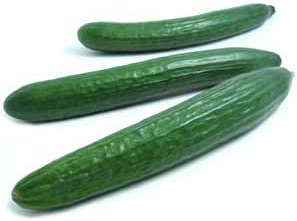 Cucumis sativas
Cucumis sativas
CUCUMBER; GHERKIN; KHIRA. Trailing. Stems rough, hairy, angular. Leaves 12-18cm, triangular-ovate, often 3-8-lobed, hispid or scabrid, lobes acute; petiole 1-2cm. Male flowers clustered in axils, female flowers usually solitary; sepals spreading; corolla about 2.5cm; ovary hispid, fusiform. Fruit clustered, globose to oblong or short-cylindric, tuberculate or prickly when young, highly variable in size and form; seeds about 11mm. Cucumis zeyheriHerbaceous perennial trailer or climber. Base woody. Stems deciduous, slender, angular, to 2m. Leaves 3-10 x 2-7cm, firm, palmate, ovate-elliptic to oblong, 3-5-lobed, acute to obtuse, lanceolate to obovate, denticulate, median lobe largest, often lobulate, scabrid or setose. Male flowers fascicled or solitary, to 2cm; female flowers solitary, to 3cm; receptacle pubescent, 3-4mm; sepals subulate, erect to 4mm; corolla slightly pubescent, 3-5mm; ovary ellipsoid to oblong, setose. Fruit ellipsoid, yellow, spiny. Angola, Zimbabwe, S Africa.
|
Home
Grow Nuts
Grow Herbs
Grow Fruit
Cyberian Index
If you like this website and want one of your own contact
Cyberian All information correct at
time of publication and open to updates as necessary. No part of this website,
or its vectors, may be produced in any shape or form, using any type or design
of medium, system, equipment or otherwise without the prior written consensual
notice of the Cyberian. Any breach of these requirements will result in the
appropriate action. If in doubt, e-mail contact is recommended.
Some components of this website were obtained as open-source software and are
used in the same non-profit manner on this website.